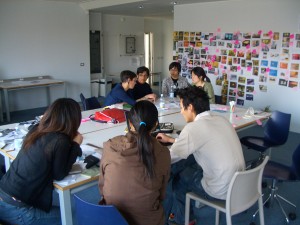Thinking and learning are strong proud words. When educational publishers or policy-makers seek to modify such terms, (re: design thinking, discovery learning, computational thinking…), the result seems less than the individual parts.
We get “design thinking” without any design; “computational thinking” without computation; “discovery learning” where the only acceptable discoveries are the ones the teacher (or textbook) already anticipated.
Increases in agency or student empowerment remain rhetorical and pedagogical progress, illusory.
I am too often reminded of the Sir Joshua Reynolds quote hanging all over Thomas Edison’s laboratories, “There is no expedient to which a man will not resort to avoid the real labor of thinking.”
Piaget teaches us that “knowledge is a consequence of experience.” Schools and teachers serve students best when the emphasis is on action, not hypothetical conversations about what one might do if afforded the opportunity.
Papert was sadly correct when he said, “When ideas go to school, they lose their power.”
Let’s say that the lessons IDEO employees gleaned from designing the latest toothpaste tube could actually be applied to education (a preposterous supposition, but let’s roll with it). By the time those ideas move from the latest blog post or conference workshop to the classroom, kids are left with an elaborate process in which brainstorming and affixing Post-It notes to walls becomes a means to solving hypothetical problems or PowerPoint reports about a topic they care little about for a non-existent audience.
Actions taken by the system, like school or classroom redesign or schedule redesign may be fantastically beneficial, but are too often conflated with the benefits of learning by being designing something personally meaningful. In other words, the adults may have learned something by being designers, but are depriving youngsters of that same quality of experience. At a time when learning is too often viewed as the direct causal result of having been taught, system-level design becomes conflated with student learning. Arranging ceiling lights in the shape of constellations to reinforce the STEM focus of the school is hardly the same as students learning science by being scientists. Doing science leads to richer learning experiences and is profoundly different from being taught about it in a room with pictures of scientists on the wall or carpet tiles arranged in fractal patterns.

Teachers, and by extension students, become consumed by hitting all of the steps in the “design process” and remembering those stages at the expense of deeper experiences in creativity, design, engineering, or computing. I am alarmed by how many schools celebrate that they allow kids to choose a topic to write a report about (paper, blog post, or PowerPoint) and then confuse such coercive, traditional, and inauthentic experiences with remarkable feats of empowerment or school reform.
It is sad and dangerous to give folks the illusion of agency without actual power or meaningful options.
Veteran educator Gary Stager, Ph.D. is the author of Twenty Things to Do with a Computer – Forward 50, co-author of Invent To Learn — Making, Tinkering, and Engineering in the Classroom, publisher at Constructing Modern Knowledge Press, and the founder of the Constructing Modern Knowledge summer institute. He led professional development in the world’s first 1:1 laptop schools thirty years ago and designed one of the oldest online graduate school programs. Gary is also the curator of The Seymour Papert archives at DailyPapert.com. Learn more about Gary here.

Using lights arranged in constellations to REINFORCE STEM education is intentional – to reinforce the importance that space plays in learning. It in no way means that students do not do science in school, simply that the intent of the space was considered in all aspects of the design to support science education in many ways.
In fact, much science is done at the school, but you wouldn’t necessarily know that, or are probably even concerned about that, really
I’m surprised that the use of a space as a third teacher was not mentioned, after all it is a Reggio Emilia principle, something that you have written about. Perhaps you didnt make the connection or think deeply enough about the intent of what I wrote I’ve included a link here so that you can familiarize yourself: http://stager.tv/?tag=reggio-emilia-approach
the first two paragraphs are spot on, esp. wrt “discovery” learning. I’m presently engaged with two colleagues on this… http://blaw0013.blogspot.com/2012/08/a-constructivists-view-on-teaching.html